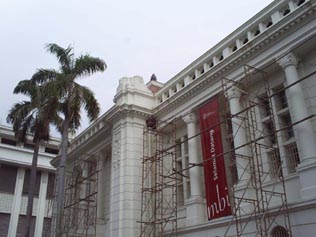Bank Indonesia Museum Restoration: Jakarta, West Java
 Restoring historically protected heritage buildings is often compared with applying theater make-up to an aging but ever-so elegant actress. Perfection can be skin deep — and with age there comes a certain beauty, we’re warned. Further still, the make-up artist working on either facade must be so dreadfully careful with all bases and shades applied — lest the matured beauty beneath disappear.
Restoring historically protected heritage buildings is often compared with applying theater make-up to an aging but ever-so elegant actress. Perfection can be skin deep — and with age there comes a certain beauty, we’re warned. Further still, the make-up artist working on either facade must be so dreadfully careful with all bases and shades applied — lest the matured beauty beneath disappear.
These warnings were echoed loudly as architectural consultants, construction companies and building material suppliers began their project to prepare West Jakarta’s Bank Indonesia Museum for her grand re-opening in 2008.
Ceramic tile manufacturers spent months experimenting and trialing colors before they found just the right red, blue and greens.
“Originality is an important feature in conserving an A-class heritage building and this can only be achieved through a meticulous selection of materials,” architect Yori Antar said.
Along with his father Han Awal, Yori is involved in several heritage conservation projects in the capital.
Han Awal succeeded in restoring the National Archive building in West Jakarta as well as inserting a new function into it.
So Bank Indonesia Museum is their next and possibly most important project.
Yet the success of this conservation effort seems to lie more in the hands of the executors: the construction companies and suppliers.
Supported by conservation and archaeological expert, Wijaya Kusuma Contractors, Yori and his father oversee the daily restoration progress.
And it’s a huge responsibility — especially for a building designed in 1924 by the then-renowned architectural firm Ed Cuypers en Hulswit.
From the outside, the neo-classic facade seems to have survived the years, with just the odd touch-up needed along the way. Apparently it’s the interior that’s giving the renovators more of a headache.
The original attention to detail behind closed doors was incredible — so there’s a lot of work to be done, said Yori.
Old marble slabs on sets of back stairs, for example, have cracks and holes.
And restoring an old slab of 5-centimeter-thick solid marble that spans the length of the stairs — isn’t something that will happen overnight.
“The suppliers must stack three layers of thinner marble slabs to reach the original thickness,” a construction worker at the site said.
For the ceramic tile manufacturer, it’s even more difficult, because they have to find just the right shade to match the original.
“But our manufacturer has still not succeeded in finding the right formula for these green tiles,” the worker said.
The museum has been, and will continue to be, a truly expensive project.
The initial construction included staircase hand railings made of solid copper — and so did the building’s piping.
Some say the building tells a story of Indonesia’s exploitation — a chapter of which is echoed in The Green Room, where stained-glass windows portray our once-heavily traded commodities, while ceiling-to-floor wall coverings are made of imported green ceramics.
So while architects working on this project will learn how to properly restore a building dubbed the city’s most elegant and beautiful — the public should read the story behind the windows, because there’s an important message beyond the pretty details.
Anissa S. Febrina